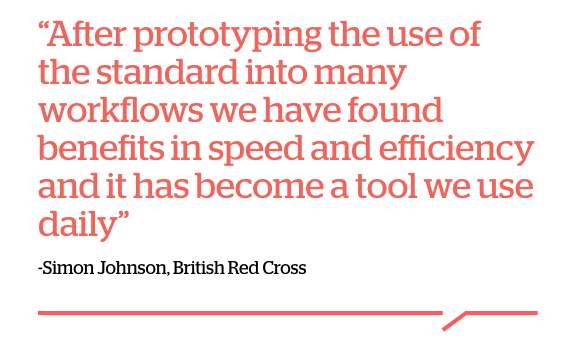Share
We are proud to announce the final release of version 1.0 of the Humanitarian Exchange Language (HXL), a simple data standard for improving information sharing during emergencies. In the 10 months since the beta release, HXL has undergone two major field trials, many smaller-scale implementations, and a formal call for comments.
Understanding humanitarian data challenges
During a crisis, responders must build a common operational picture from rapidly-changing information, much of which is hidden away in spreadsheets and proprietary databases. Sharing the data among dozens or hundreds of responders is typically slow, manual work, with field staff copying and pasting data from different sources, hoping to find and fix errors along the way.
“HXL allows responders to aggregate the information necessary to develop a ‘common operational picture’ between all humanitarian actors”
-Laurent Pitoiset, UN Refugee Agency
A simple solution for messy data
To address these challenges, the HXL standard takes a idea from social media — the hashtag — and applies it to data. Data providers can add simple shared hashtags (like #country or #inneed) to columns in their existing spreadsheets (or database output) to improve quality control, automation, and interoperability. For details, see the 30-second HXL Tutorial.
“After prototyping the use of the standard into many workflows we have found benefits in speed and efficiency and it has become a tool we use daily”
-Simon Johnson, British Red Cross
Unlike most data standards, HXL is cooperative, not competitive. The HXL standard does not aim to replace the reports that aid responders generate now, but simply to make them more effective. Data providers can add HXL hashtags to any dataset they produce, and are free to create new hashtags when the core ones do not suit. The goal is to improve data sharing incrementally, starting with the skills, processes, tools, and capabilities that humanitarian workers already have available.
Who is using HXL?
UNHCR currently publishes its Population Statistics on international displacement using HXL hashtags. UN OCHA has created tools for working with HXL-tagged datasets, including an online data-processing service and a collection of open-source software. Simon Johnson of the British Red Cross has written a set of use cases describing that organisation’s use of HXL in the Nepal and the European Refugee crises. The volunteer community, including the Standby Task Force, has used HXL in several initiatives, and UN OCHA has run HXL field pilots in Guinea and Nepal.
Other organisations are planning to add HXL support soon. During 2016, the Humanitarian Data Exchange will add support for instant validation, analysis, and visualisation of HXL-tagged data.
Changes from HXL 1.0 beta
The final release of HXL 1.0 is nearly identical to the beta release. Based on feedback and field experience, the working group decided to restore the #event hashtag (which had been present in earlier drafts of the standard) to mark occurrences within a crisis, and to add the #group hashtag, to distinguish groups that are not part of an aid response (e.g. paramilitary organisations). See Changes from previous versions in the HXL standard for more information.
Next steps
Version 1.0 of the HXL standard defines a core set of general hashtags applicable to many types of humanitarian data, including places; people and households; operations; crises, incidents and events; and general metadata.
Feedback during the comment period pointed to the need for more coverage from the beneficiary perspective, including possible #service and #complaint hashtags. These would have a place in a core, cross-sector HXL hashtag dictionary, and the working group plans to make them an early priority for the future HXL releases.
The HXL working group will also begin discussion with different sectors in the humanitarian community — both local and international — about how to agree on standard hashtags and code lists for specialised areas such as healthcare and logistics.
Thanks
HXL’s development began in 2012, when Chad Hendrix and Andrew Alspach at UNOCHA identified a need to improve data exchange in the humanitarian community. Over the subsequent years representatives from many other organisations have been involved in the standard’s development, including the British Red Cross, the ICT4Peace Foundation, IOM, Save the Children, ThoughtWorks, UK DFID, UNICEF, USAID, Ushahidi, the Volunteer Standby Task Force, WFP, and the World Bank. The Humanitarian Innovation Fund and UN OCHA have provided financial support.
Andrej Verity has published a blog post with more information about the project’s history and the many people involved, and ALNAP has published an innovation case study about the standard’s development.
